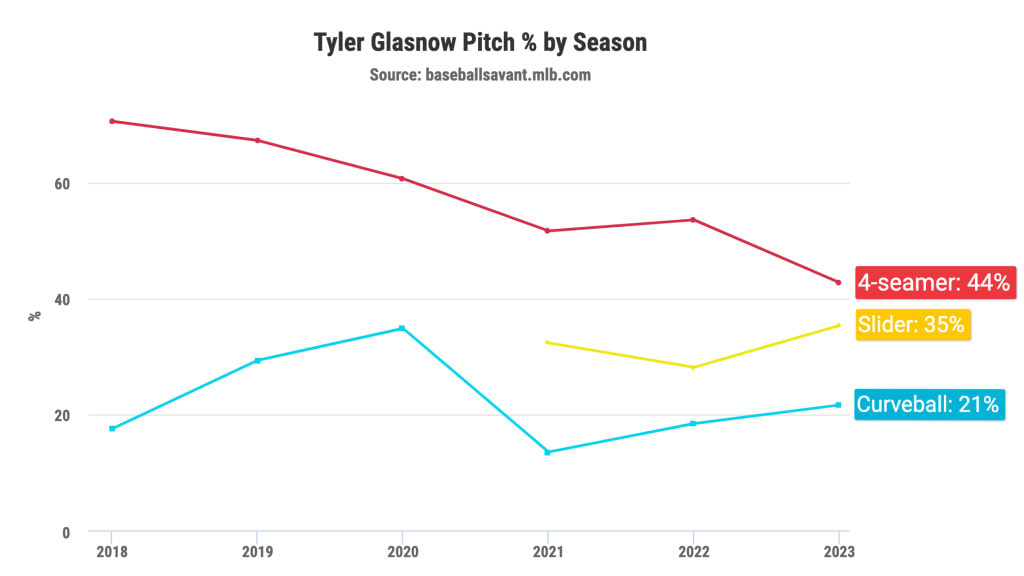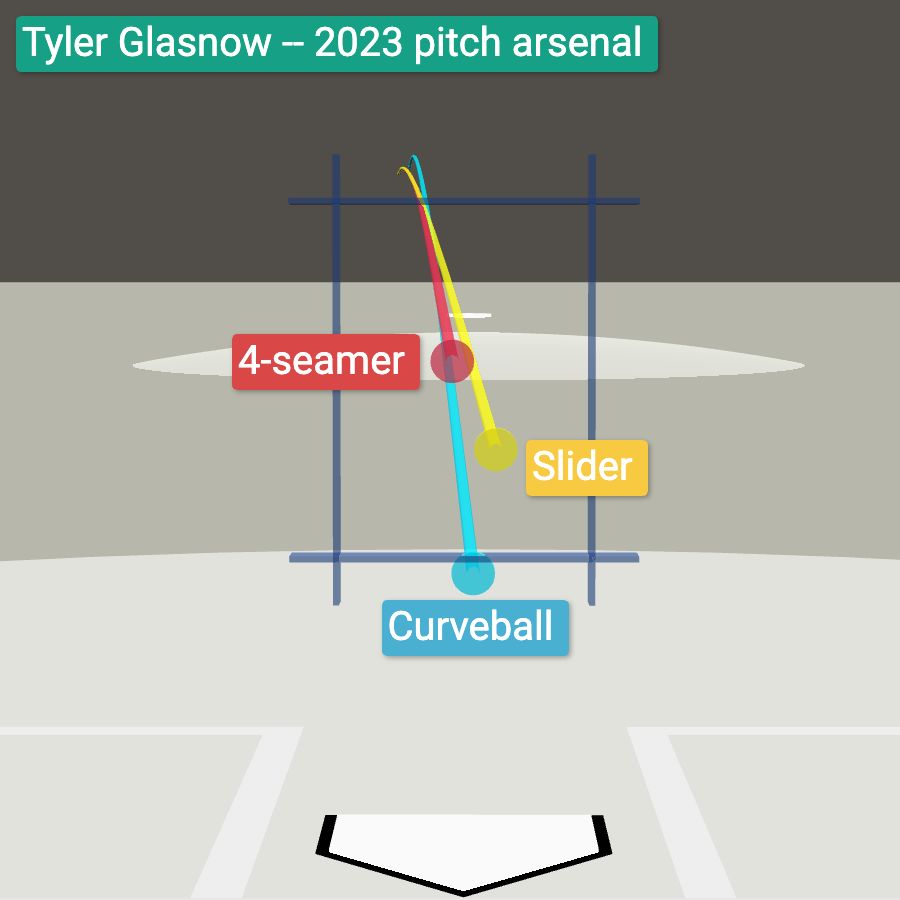Tyler Glasnow is ready for the big stage in L.A. He stepped up as the Rays' ace when Shane McClanahan went down with Tommy John surgery in 2023, and he's the type of dominant pitcher who's fit to step in as the new ace of a juggernaut Dodgers team that also just landed Shohei Ohtani.
Here's what makes the big right-hander such a force on the mound.
Of all the prototypical power pitchers in the Majors today, Glasnow might be the most prototypical. He has the ideal combination of stuff -- the explosive upper-90s fastball, the wipeout 90 mph slider, the drop-off-the-table mid-80s power curveball -- and size. Glasnow is 6-foot-8 with massive release extension -- he releases his pitches 7.5 feet in front of the rubber, one of the highest marks for any pitcher, which gives hitters even less time to react to the arsenal that's already designed to overwhelm them.
That's what made Glasnow one of the nastiest strikeout pitchers in baseball during his tenure in Tampa Bay. Glasnow's 12.2 K/9 as a Ray ranked fourth among starters for that time period, 2018-23, behind only Spencer Strider, Chris Sale and Jacob deGrom.
In 2023, Glasnow struck out 162 batters in 120 innings, right in line with his Rays career numbers. But that's not the whole story. He also finetuned his repertoire to become a more balanced power pitcher.
That Glasnow should be the one the Dodgers are getting in 2024. And that means three things:
1) Balanced usage
Glasnow's fastball usage has been trending steadily downward ever since he joined the Rays. For his first few seasons with the team, that meant he was throwing a lot of curveballs. Glasnow back then was essentially a two-pitch pitcher: fastball-curveball, similar to what Spencer Strider does with the Braves right now with his fastball-slider combo.
But in 2021, Glasnow added a slider, and now he has three pitches to mix instead of two.
Glasnow's 2023 pitch usage
- 4-seamer: 44% (2021-22: 52%)
- Slider: 35% (2021-22: 32%)
- Curveball: 21% (2021-22: 14%)
Glasnow's decrease in four-seam usage has meant a steady narrowing of the gap between his fastballs and breaking stuff -- he threw more of both his slider and curveball in 2023 compared to the previous two seasons since he went to the three-pitch mix.

So the Dodgers are getting a Glasnow with the most balanced pitch mix of his career.
2) Balanced velocity
All of Glasnow's pitches are hard. His fastball is a power fastball, his slider is a power slider, his curveball is a power curveball.
But what he did last season was make the slider a perfect fulcrum between his fastball and curve.
Glasnow's 2023 velo by pitch type
- 4-seamer: 96 mph
- Slider: 90 mph
- Curveball: 84 mph
Glasnow has the same 6 mph velocity step from four-seamer to slider to curveball. When he introduced the slider in 2021, it was a lot closer to his curveball than his fastball. That season, Glasnow's fastball averaged 97 mph, his slider averaged 88 mph and his curve averaged 84 mph. There was a near-10 mph dropoff from his fastball to his slider, and his breaking pitches blended more.
Glasnow had Tommy John surgery that summer, and when he returned late in 2022, he started throwing the slider a little harder, which differentiated his pitch velo more evenly. That continued in 2023.

So the Dodgers are getting a Glasnow with the most balanced pitch velocity of his career.
3) Balanced attack
Glasnow's entire arsenal has a vertical profile. All his pitches come straight at you.
It's an appropriate style considering the type of power pitcher he is: Drive down the mound, deliver high-velocity pitches from as close to home plate as possible and let those pitches explode right past the hitter, whose time to react has been minimized.
Glasnow starts with his true, rising four-seamer that carries through the top of the strike zone. Then his slider bites down to the lower corners. And finally, his curveball drops as the hammer below the zone, the mirror image of his rising fastball.

About 20 inches of vertical movement separates each pitch: Glasnow's slider drops about 20 inches more than his fastball, and his curveball drops about 20 inches more than his slider. But none of those three pitches move more than two inches horizontally, so the hitter can't really distinguish them from the direction they're breaking.
Glasnow's 2023 pitch movement
- 4-seamer: 13 inches drop | 1 inch run
- Slider: 32 inches drop | 2 inches break
- Curveball: 53 inches drop | 1 inch break
All three pitches travel along the same line toward the hitter, and with Glasnow's velocity and release extension, it's almost impossible to identify whether the ball is going to elevate to the top of the zone, snap to the bottom or bury itself in the dirt. That's why hitters swung and missed against Glasnow 35% of the time in 2023, the third-highest whiff rate generated by any starter behind only Strider at 39% and Blake Snell at 37%.
To get that tunneling effect between his different pitch types, Glasnow has taken some of the horizontal movement off his curveball, which used to average five to six inches of break and now is sitting at just one inch.
So the Dodgers are getting a Glasnow who's attacking hitters in the most balanced way that he ever has, too.
